



Interview with
Professor Jenny Graves







About Jenny Graves
Jenny Graves was born in Adelaide. She attended Highgate primary school and Presbyterian Girls' College, both in Adelaide.
Geography, creative writing and Art - not science! - were Jenny's best subjects at school. She topped the State in Geography in her final year at school and won prizes for her essays and art. Other subjects studied in her final year at school were English, Modern History, Latin, Biology, Chemistry, Physics and, through an outside tutor, Mathematics. Jenny was not able to study Maths at her school, it was not considered an important choice for 'young ladies'! (I'm sure that things have changed at that school now!)
Jenny has two degrees from Adelaide University; BSc (Hon) and MSc which was completed in the Departments of Genetics and Physical Chemistry - an unusual combination that reflected Jenny's diverse interests at the time. Jenny's PhD was completed in Molecular Biology at the University of California (Berkeley).
Jenny has worked in many interesting places, sometimes for extended periods, sometimes for collaborative work lasting a week or two. Some of these locations are:
- University of California, San Francisco, in the Department of Anatomy
- University of Washington, Seattle, in the Department of Genetics
- Indian Institute of Science, Bangalore, India
- National Cancer Institute, Frederick, Maryland USA
- Cambridge University, UK, in the Department of Genetics
- La Trobe University, where Jenny has a Personal Chair in Genetics in the Division of Biochemistry and Genetics
Jenny met her husband, John, in the USA. John was a molecular biologist but his career changed to transportation and planning John is also involved in local government and is a member of the Nillumbik Shire council. Jenny and John have two daughters. Alison, the elder, is currently studying for a Masters in Public Health at University of California, Berkeley. As part of a part-time job analysing data from African TB and AIDS patients, Alison has been sent to Zimbabwe, Africa to set up a large epidemiological study. Erica, the younger of Jenny's girls is at Melbourne University studying for an Arts/Science combined degree.
For recreation, Jenny enjoys music; she's a singer with the Tudor Choristors and she writes and performs genetics songs to liven up her lectures. She also loves to attend classical concerts and the opera. Jenny's garden provides her with relaxation at home. Art is still useful for Jenny, she is currently working on cartoons and diagrams for her new book on sex.
 Back to the top of this page
Back to the top of this page

The Interview with
Professor Jenny Graves
The topic Jenny chose to discuss was:
The how and Y of sex determination in mammals.
Interviewer: What is the main purpose of your research or the genetic technique you use?
Prof Graves: To find out what genes are involved in determining maleness and how they work.
Interviewer: Can you describe briefly how you are doing whatever you do?
Prof Graves: The Y chromosome is essential for male sexual differentiation. We isolated Y chromosome genes from marsupials, mammals that are quite distantly related to man. We looked for, and found, genes that are homologous to human genes. We compared the base sequence and the location of these genes on the chromosomes and we investigated how the genes are expressed. To do that we isolate mRNA to find out in what tissue and at what stage the gene is transcribed.
Interviewer: Who or what (animal or plant) will benefit from your research/techniques?
Prof Graves: Humans will benefit down the track. Firstly, because we are all interested in sex (!) and this will help explain the biological processes that make males male and females female. Secondly, there could be medical spin offs from this work, especially in new diagnoses and treatments for people with sexual abnormalities.
Interviewer: What are the economic implications of your applied genetics? (How expensive is it to do? What will be/are the cost benefits of the outcome?)
Prof Graves: Like all research in Australian universities, this work has been carried out on a 'shoestring' budget. I have had a grant of approximately $50 000 per year for the last 8 years for this work. That has paid for some salaries, also equipment, chemicals and all the other things needed to run a laboratory.
The financial benefits from the work could be enormous if someone was to apply it to the development of clinical diagnoses and treatments. We are not in the position to do that, but a big drug company might.
Interviewer: Historically, what is the scientific background to the research you are now doing?
Prof Graves: My initial interest was in X chromosomes and the inactivation of the X chromosome in marsupials. This is interesting because we can't even imagine how thousands of genes are all turned off at once. The process is a bit different in marsupials than i humans, so I had started mappinf the marsupial X chromosome. I didn't think that I was interested in the Y, although I was aware of the tremendous interest in cloning the master switch gene (testis determining factor, TDF) which we knew must lie on the Y.
Then in 1988 David Page (working at the Whitehead Research Institute in Boston, USA) cloned what he believed to be the human TDF. David asked me if I would check out this gene in my marsupial system and show that it lay on the Y chromosome as it does in man and mouse. I did, but the results brought a big surprise which led to the research that still continues in my lab.
Interviewer: For a Year 12 Biology student to understand what you are doing, some background knowledge of biological concepts will be needed. Can you tell me what biology is relevant to what you are doing, and why?
Prof Graves: Students need to understand how male of female sex is determined by the sex chromosome carried by the sperm. It has been known for a long time that there is something about the human Y chromosome that determines maleness. A person with 44 autosomes and XX is expected to be female, and a person with 44+XY is expected to be male. We know that the Y, rather than the number of Xs, determines maleness because there are some people with just a single X (XO, Turner Syndrome) and they are female. Other people, with 2 Xs and a Y are male (XXY Kleinfelter Syndrome).
It's possible to find out what part of the Y chromosome contains TDF by studying people with unusual sex chromosomes for their apparent phenotypes. These people fall into tw groups:
- Female: XY but with an incomplete Y chromosome (About 1 in 500)
- Male: XX but with a tiny piecs of chromosome Y attached to an X chromosome. (About 1 in 20 000 males)
To understand completely what's happening here, students must know about what occurs normally in meiosis to produce gametes, and also what can go wrong as deletions or translocations occur to create chromosomal mutations. Many of these mistakes occur during pairing and crossing over of the chromosomes at the start of meiosis, which students should also understand. The X and Y chromosomes normally only pair and cross over at their tips during meiosis, but sometimes this process goes wrong and produces one or another kind of mixed up chromosomes.
In talking about the TDF gene, students need to know what is meant by the term 'gene' and how the base sequence in a gene's DNA is the code for the mRNA formed by transcription. The mRNA, in turn, carries the recipe to the ribosomes for the amino acid sequence of the gene's protein product. We have now found that the TDF gene, which we actually call SRY (Sex Region on Y chromosome), is a regulatory gene, though we still don't know how it works.
Students need to realise that not all genes are 'switched on' in all tissue at all times - the result of that would be chaos. Tissue development and differentiation requires an orderly sequence of switching on and off of the correct genes at the correct time, and there are regulatory genes that do just that. In fact, it has always been assumed that the SRY gene, located towards the tip of the Y chromosome, works as an 'ON' switch rather than as an 'OFF' switch. However it could work more indirectly. Let me try to explain how it could work:
All of us have the ability to make testes, that is all male embryos and all female embryos have this ability. That's determined by a set of autosomal genes. So the difference between males and females is whether these genes get switched on or not.
The simplest scheme is that SRY initiates a sequence of events in the undifferentiated gonad tissue.

We now have evidence that another related gene, called SOX 9 is one of the other genes in the sequence. People lacking one copy of this gene have a crippling didsease and may also be sex-reversed XY females. We don't know how SRY interacts with SOX 9, but one possibility is that is acts to repress another gene that in turn represses SOX 9. In females, with no SRY, this inhibitor blocks SOX 9 and no testes are formed. This inhibitor may well be another related SOX gene. So in females, that's the end of the story. The SOX gene prevents us from developing testes and the hormones that testes release don't occur and disrupt our femaleness. So we turn out to be beautiful girls.

Now to make a male, something is needed to inhibit the repressor gene. That's where the SRY gene comes in. It's possible that the SRY gene might inhibit the repressor gene. So the pathway to make testes is free to 'do its thing'! In effect, you can say that two negatives (the inhibitory repressor and SRY genes) have combined to give a positive - the production of testes.
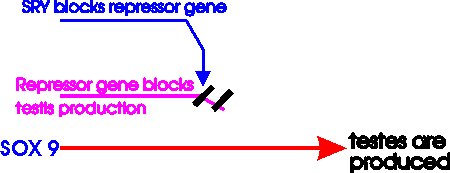
In the embryo, the developing testes release two hormones that keep the maleness happening whilst causing the female bits to wither away. If anything happens to block testis differentiation or hormone action in an XY embryo, the baby develops into a female. This means that males are in fact, the odd ones. The 'ground state' that we all start with is to be female. But the presence of the SRY gene disrupts this and the 'aberrant state', maleness, is the result.
To understand how our work with marsupials fits into the story of the search for the maleness gene, students need an understanding of the biological basis for evolution. Basically, the idea is that all mammals came from an ancient common ancestor. But at several points along the way, there were major evolutionary splits. This gave rise to the three major groups of mammals around today, the monotremes (such as platypus and echidna), the marsupials (there are many of these in Australia; kangaroos, wallabies, possums, koala and marsupial mice are some) and the eutherians (often called 'placentals' although many marsupials also have placentae) which include humans, cats, cows, goats, rats ... Here's a diagram to show how we believe these groups arose.
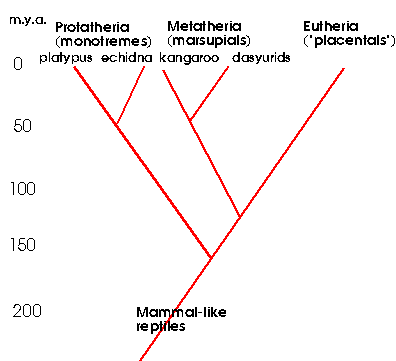
If David Page's gene were the 'real' TDF, it should lie on the Y chromosome in marsupials as well as eutherians, since the marsupial Y is also testis determining.
Interviewer: I now need to know something of the techniques used in your research. Can you tell me what techniques are important, and why they are important?
Prof Graves: I think that this is easiest to understand in several parts. I need to explain briefly what David Page did first, then I'll tell you what the people in my group have done to add to the story to date. Some of this work was done here at La Trobe, in my lab by Drs Jamie Foster and Andrew Sinclair who got their PhDs here and worked later in Peter Goodfellow's group at the Human Molecular Genetics Laboratory, Imperial Cancer Research Fund, in London, UK and later in the Genetics Department at Cambridge University.
Part 1: David Page isolates what he believes to be the TDF gene.

Obtain blood samples from patients who are XY female or XX male.

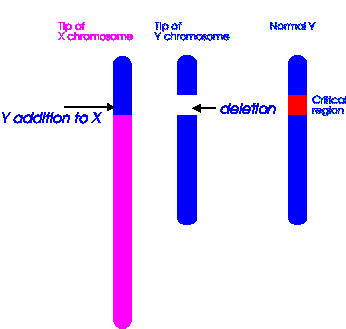
Look for a region missing in the XY female and present in the XX male by lining up the molecular tags present in each.

Clone this region by cutting it up and splicing the fragments into many virus particles.
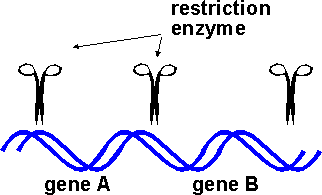
Use restriction enzymes to cut the DNA in the region of interest into many pieces.

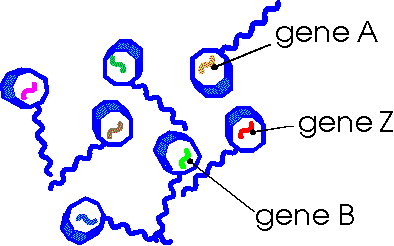
Insert the pieces into many lambda phages and grow them up as plaques to create a gene library.

Pick individual plaques. Isolate each one and grow up lots of the recombinant virus.


Grow up the phage library to clone millions of copies of each DNA fragment.

Check each lambda phage clone for male specificity by comparing the fragments that bind it in male and female DNA.
(This is done by Southern Blotting).
Cut DNA from male and female pairs of many species.
(Humans, chimpanzees, monkeys, cats, goats ...)
(This is known as a "glossary.html#Noah's Ark Blot")


Separate the DNA fragments by electrophoresis.

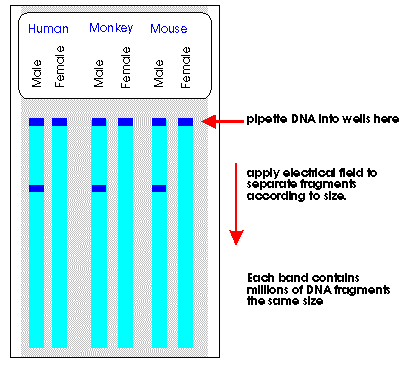
Probe the blot with the radioactively tagged cloned DNA sequence to locate the fragment carrying that sequence.

Result: One clone detected a band in the male but not the female DNA.
This was the clone that carried the candidate TDF gene, which must be present on the Y chromosome.

Send some phage to La Trobe for confirmation that this gene is present in male but not female marsupials because it is on Y chromosomes.

Part 2: Jenny Graves' students get surprising results
Repeat the David Page Noah's Ark Blot experiments with a number of marsupial species' DNA
(Red kangaroo, tammar wallaby, marsupial mouse, possum and others.)

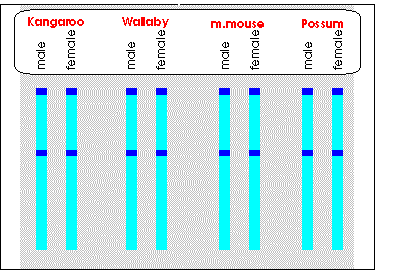
Bands are present in both sexes of the animals tested.

Clone and map the gene to marsupial chromosome 5, an autosome present in both males and females.
(This is a funny place to find a sex determining gene! How could it possibly determine maleness? Could it work?)

Repeat the experiment with monotreme DNA (platypus)

Bands present, again in both male and female.

Clone and map the gene in the platypus. Find that it's located on platypus chromosome 1, and again there's nothing on the platypus Y chromosome.
Our conclusion from this work was that it was the wrong gene! We would have expected that all mammals would have the TDF gene on their Y chromosomes if it was the critical gene in sex determination. But it appears from our work that this gene is a recent addition (no more than 80 million years ago) to the Y chromosome of the eutherians.
This naturally led us to wonder what and where is the elusive testis determining gene? The chromosome analysis that had pointed to this gene in the first place again provided the clue.

Part 3:Young Australian researchers help find the real sex determining gene.
Dr Andrew Sinclair who had obtained his PhD in Genetics at La Trobe, went back to the drawing board, finding more XX male patients with even smaller bits of the Y chromosome. This defined a new 'critical region' of the Y, nearer to the tip. By then Andrew was working in the laboratories of Dr Peter Goodfellow in the UK. He and his coworkers, including another of my PhD students Jamie Foster who was on a long 'holiday' in London, took up the challenge.
Andrew cloned a library of genes from the new critical region of the human Y chromosome and used them as probes to look for similar genes on the chromosomes of a variety of mammal species - another set of Noah's Ark Blots. He found another gene that was present only in males and called it SRY (Sex determining Region on the Y). Jamie Foster returned to do the marsupial work at La Trobe, and confirmed the location of the gene on the Y chromosome of a variety of marsupials' and monotremes' Y chromosomes.
This time the gene turned out to lie at the tip of the human Y chromosome. In fact it is quite close to the ZFY gene of David Page, and now that the region has been examined again, it is found to be absent in the XY female but present in the XX male. David Page was just unlucky to choose an XY female parient with two holes in her Y chromosome.
So at last, we believed that we have found the 'real' TDF gene. We called it SRY (Sex determining Region on the Y). This was confirmed by the finding that some XY females with an intact Y chromosome have single base changes within the SRY gene. These people produce a mutant SRY protein that doesn't work to determine testes.
In London, another Melbourne student, Peter Koopman (now at the University of Queensland) cloned a mouse version of the SRY gene and injected it into mouse embryos which were XX. This technique, which involves the injection of the gene into the embryo cells and implanting them back into a mouse is called 'transgenesis'. From hundreds of injections Dr Koopman obtained a few transgenic mice, the most famous of which was named "Randy". In spite of being XX, Randy had all the characteristics of a male mouse, including testes and behaviour that certainly looked as if s/he 'thought' as a male! It was not difficult to choose a name for this mouse! This was powerful evidenc that the SRY gene was indeed the TDF gene.
So when David Page found what he believed to be the TDF gene from the human Y chromosome, he wanted me to check that his TDF was on the Y chromosome, as you would expect if it was the right gene. It was and it wasn't!
We got another surprise when we sequenced the marsupial SRY and compared the sequence with mouse and human SRY. athe sequences were nothing like identical, which is what we would have predicted for such an important gene, especially one that turns on other genes. This may tell us that the gene works as an inhibitor rather than an activator.

Part 4: The work continues
Recently, many people have been puzzling out how the SRY gene works.
We do this by searching for the mRNA that is copied from the gene in its target tissue. In mouse, SRY is turned on in the embryonic gonad just before testes develop, which makes sense. But in human and marsupials it is on in lots of tissues suggesting that it regulates something else 'downstream'. This story has become quite complicated, as I explained earlier, since it is pretty clear that this gene is part of a complex sequence of regulation of the pathway to testis formation.
Other researchers, all around the world, are now looking at SRY-like genes in a variety of animals. One related gene, SOX 9, seems to be involved in making testes, because it is turned on in the developing gonad in males but not in females. SRY may regulate SOX 9 either by activating it or by inhibiting something that inhibts it, as I explained before.
SOX 9 is present in all vertebrates and is turned on just before the testis is formed in birds as well as the mouse. One of our present PhD students even found that it's turned on in male alligators, even though they don't have sex chromosomes at all! It look like SOX 9 has been the real TDF for millions of years. Un contrast, SRY is not present in the sex chromosomes of reptiles and birds, and we can't even find it in the platypus. So it must be quite a new gene in the evolutionary sense.
There is still a great deal of work to do on these genes, but the story so far has full of twists and turns...

Interviewer: What do you see as the major biological implications of the work you are doing? For example; Are genotypes or phenotypes being altered? Is a species survival potential increased? Will someone or something have a better quality of life?
Prof Graves: Sex and reproduction are absolutely critical for species survival, as well as human wellbeing and even for the control of pest mammals. Two specific examples come to mind here.
Firstly, we now have a great deal of information about the genes of the Y chromosome of humans. This knowledge means that we have the ability to investigate the diagnosis of people that are unaccountably sterile or whose sex is uncertain. If we understand exactly how gender is determined normally, then we are in a good position to find out what's wrong when errors have occurred.
The second use of this technology is in contraception. We have worked on contract the New Zealand Government on the problem they have with possums eating up their forests. (You may not realise that possums were introduced to New Zealand from Australia for the fur trade, and there are now 70 million of them! There are no predators, little disease and no competition for their niche.) If we can use our knowledge of the possum Y chromosome to develop sterile males (for instance, in a similar way to the development of Randy the mouse), then the release of these into the New Zealand bush will provide competition for the 'real' males and the rate of population growth should drop.
Interfering with sexual differentiation is also under consideration as a biological control method in Australia. Foxes, feral cats and dogs and rabbits are all species which may be managed this way in the future.
Interviewer: There is often discussion or debate about issues associated with biotechnology. What is one such issue relating to your work? Can you outline the arguments of the opposing sides of the debate please?
Prof Graves: Again, a number of issues come to mind:
| Issue |
Arguments for |
Arguments against |
Should all athletes be screened for the SRY gene?
(Author's note, I found some interesting discussion on this topic on the Internet. A sociology site in Britain and an American newspaper article might be worth a look.) |
Yes, particularly as merely checking that an athlete is XX does not always mean that s/he is female. Since XX males with SRY do exist, they would have an unfair advantage if they were competing in women's events because they can manufacture testosterone. Also XY females without SRY are definitely female and should be allowed to compete as females. |
No, even if the SRY gene is present in an XX person, without some of the other genes of the Y chromosome the person cannot make sperm. So these people are not fully functional males. Also, there can be other types of mutants, for example of the androgen receptor gene, so testosterone can't work. This is a complex area of biology and a simple solution ignores many possibilities.
|
| Should all foetuses be screened for SRY abnormality |
Yes, then parents can choose whether or not to bring a baby with a socially distressing abnormality into the world. |
No, this is "playing God" and since it is not life-threatening we have no right to interfere. |
| Should we use recombinant SRY technology as a method of pest control? |
Yes. It's species specific, humane and will help to solve a difficult problem. |
No, we don't know enough about these genes yet. What would happen if the gene 'escaped' from the pest species and caused the sterilisation of males of a wanted species, maybe even humans? |
Interviewer: Can you suggest some reading material relevant to anything we have discussed about your work, its implications and issues associated with it?
Prof Graves: Because this is such a 'sexy' topic, I have had many requests for interview about it over the years. Some of the articles that have been written as a result would be suitable for the students I'm sure. The older articles should be read first, as the story develops from the late 1980s to the present time.
Here's a list of articles school librarians may be able to find for the students:
- Susan Peak: "Koala research blows master-switch sex gene theory", The Herald: 3 January 1989, p2
- Anon.:"The gene that determines sex in marsupials", New Scientist, 25 February, 1989
- Graeme O'Neill: "Male master gene eludes scientists", The Age: 15 May 1989, p15
- Jennifer Graves: "The race to find the sex gene", The Age (Education Age), 20 June 1989
- Jennifer Graves: "Sex determination in mammals", Today's Life Science, March 1990
- Graeme O'Neill: "Gene find a kick in the rib for Adam", The Age: 19 July 1990, p1
Also a search of the Internet should provide plenty of additional reading matter. (Author's note: I used Alta Vista and typed in "XY female", that gave about 30 hits. "XX male" came up with some strange engineering hits -does this tell us something about engineers? - but some good biology hits too. I didn't try "SRY gene" or "Y chromosome" but I'd be surprised if they were not useful too.)
Interviewer: Thank you for your time.
 Back to the top of this page
Back to the top of this page

Further information relevant to Professor Graves' work
You can read more about the work of Professor Graves, and the people in her lab, by clicking here.
For ideas on where you might find additional resource material, look again at the section Resources on another page at this site. And don't forget the power of the Internet to provide you with information. A well thought out search, using a search engine such as Alta Vista, should provide more information than you can possibly use!
Please do not phone Professor Graves for further information for your CAT. She, like the rest of the staff in Genetics, is a busy person. However, if you think we can help you some more, use either the comment form or the email address for this site and we will do what we can.
 Back to the top of this page.
Back to the top of this page.

We welcome your comments about this project.
Click on Kick-the-cat to return to the VCE Biology Students' Home Page


This page is maintained by Jenny Herington, who can be contacted at bio_cat@bioserve.latrobe.edu.au by email.
All of the pages at the VCE Biology Students' site are copyright © Biochemistry, LaTrobe University.
Last update: 25 September 1997
















![]()
![]()
![]()